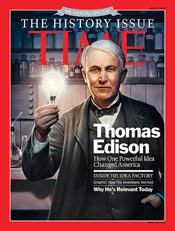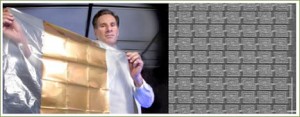Something very small [nanotechnology] is happening in the world of solar panels, but it promises big changes. It cuts to the heart of solar panel engineering, and the big dream solar aficionados have harbored for decades……thin film technology that is both cost effective and practical.
With nano-solar technology, the panels themselves change as well, their manufacturing becoming more like a film making process than adhering silicon-like materials to glass substrates. The use of customized nano particles has the ability to make the cells better able to capture incoming solar radiation, thereby increasing panel efficiency; and also enabling a cheaper manufacturing process. To give you a sense of the scale, a nanometer is equal to 1 billionth of a meter.

Check out a photo below of Konarka’s, plastic, organic, thin film material, and visit them to see their typical product performance spec sheet. Konarka Technologies is located in Lowell Massachusetts, and was originally founded in 2001 by a team of researchers at UMass at Lowell, including Mr. Howard Berke, who now serves as Konarka’s Chairman and CEO.
Nanosolar, is now marketing their nanosolar panels, boasting a 15% panel efficiency. On a thin piece of aluminium, the company adds a nanoparticle ink, at a rate of printing 100 feet of solar cells a minute. They can produce panels [containing many solar cells] for 60 cents per watt, retailing them for about $1.00 a watt when production is full-scale. A fully installed Nanosolar panel system would cost about $2.50 a watt, much lower than the $6-8 a watt today with conventional solar panels. You can see an interesting video of their panel making operation and also via this photo below.
Nanosolar was founded in 2002, recently benefiting in 2010 from a revamped team of management talent with experience in growing technology companies into potent billion dollar organizations. The new team is headed by Mr. Geoff Tate, Chairman and CEO, and located in San Jose, CA.
The U.S. Department of Energy’s Idaho National Laboratory has teamed up with Microcontinuum Inc. and the University of Missouri to develop a very interesting nanoantenna which can capture up to 80% of the sun’s mid-infrared rays. Spiral nanoantennas, 1/25th the width of a human hair, do the work. These little babies can also harvest energy after the sun goes down! See photo below, and check out this website and fascinating video. Since these arrays absorb infrared radiation, they also absorb the sun’s infrared energy reradiated by the earth after dark. Similarly, they also take in heat from industrial processes. This opens up a whole series of applications for absorbing waste heat and reradiating it as electricity, effectively cooling buildings, computers, equipment, etc. … without air conditioning. This could be revolutionary in just a few more years. From tiny nanotechnology, big new applications grow.
Microcontinuum was originally founded in 1998 by a former team of Polaroid scientists and engineers. Dr. W. Dennis Slafer is currently President and CFO, Cambridge, MA.
New Energy Technologies, Inc. says it’s come up with a patent-pending method of spraying windows with a nano-thin photovoltaic material. The spray is an organic semitransparent material that converts sunlight to electricity. Using this technology the company will produce its SolarWindows, equipped with a nano film 1/1,000th the thickness of a human hair. Researchers found that its super small solar cells can harness more artificial light than other solar cells “under normal office lighting conditions, without the benefit of outside natural light from windows.” Check them out!
Mr. John A. Conklin is President and CEO of New Energy Technologies, located in Columbia, MD.
Editor’s Deep Dive
- http://www.solarfeeds.com/cooler-planet/12072-nanotechnology-pushing-the-limits-of-solar-panels
- http://www.greenlivingonline.com/article/not-your-parents-solar-panels
- http://www.nanosolar.com/
- http://nanogloss.com/nanotechnology/conserve-energy-with-nanotechnology-solar-panel/
- http://www.newenergytechnologiesinc.com/solarwindow
 Thomas Edison was a big fan of solar energy … “I’d put my money on the sun and solar energy. What a source of power! I hope we don’t have to wait until oil and coal run out before we tackle that.”
Thomas Edison was a big fan of solar energy … “I’d put my money on the sun and solar energy. What a source of power! I hope we don’t have to wait until oil and coal run out before we tackle that.”
Time ® is a registered trademark of Time Inc.



